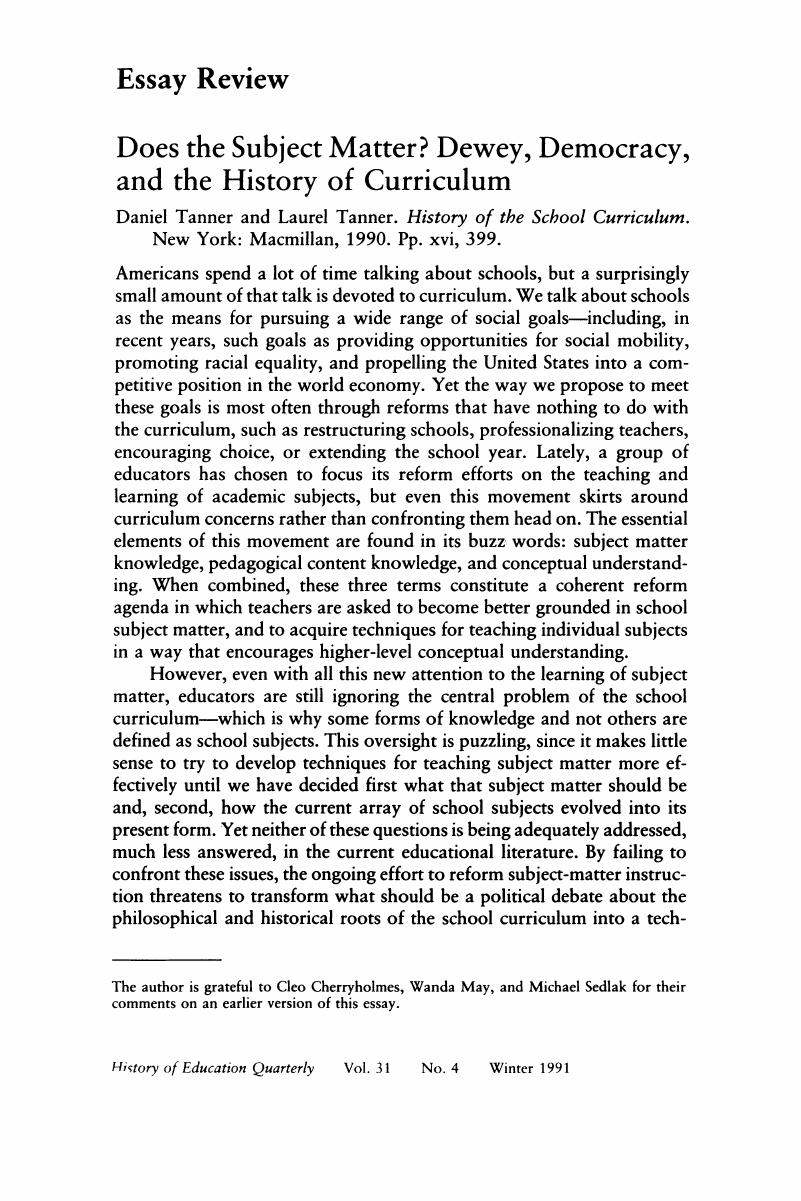Published online by Cambridge University Press: 24 February 2017

1. Clifford, Geraldine Jonçich, “The ‘Sticky Wicket’ of Curriculum History,” Educational Researcher 19 (Dec. 1990): 27.Google Scholar
2. See, for example, the discussion of this problem by Lagemann, Ellen Condliffe, “The Plural Worlds of Educational Research,” History of Education Quarterly 29 (Summer 1989): 186–214.CrossRefGoogle Scholar
3. The Tanners' frequent references to “battles” are reminiscent of another great believer in educational progress, Cubberley, Ellwood P. For example, according to the Tanners, the three main periods in American educational history are defined by the “battle for free, secular state school systems,” the “battle for universal secondary education,” and the “battle for extension of opportunity for higher education” (p. 134).Google Scholar
4. Labaree, David F., “Politics, Markets, and the Compromised Curriculum,” Harvard Educational Review 57 (Nov. 1987): 483–94.CrossRefGoogle Scholar
5. Sedlak, Michael W. et al., Selling Students Short: Classroom Bargains and Academic Reform in the American High School (New York, 1986), 182.Google Scholar
6. Turner, Ralph, “Sponsored and Contest Mobility and the School System,” American Sociological Review 25 (Oct. 1960): 855–67.CrossRefGoogle Scholar
7. Weber, Max, “The Chinese Literati,” in From Max Weber: Essays in Sociology, ed. Gerth, H. H. and Wright Mills, C. (New York, 1946), 416–44.Google Scholar
8. However, applying a Dewey-style curriculum to a selective subset of the student population serves the same differentiating function as the traditional curriculum, as in the case of private progressive schools designed for an upper-middle-class clientele.Google Scholar
9. Schultz, Theodore W., Investing in People: The Economics of Population Quality (Berkeley, Calif., 1981).CrossRefGoogle Scholar
10. Collins, Randall, The Credential Society: An Historical Sociology of Education and Stratification (New York, 1979); Thurow, Lester, “Education and Economic Equality,” Public Interest 28 (Summer 1972): 66–81.Google Scholar
11. Lortie, Dan C., Schoolteacher: A Sociological Study (Chicago, 1975).Google Scholar
12. Cuban, Larry, How Teachers Taught: Constancy and Change in American Classrooms, 1890–1980 (New York, 1984).Google Scholar
13. McNeil, Linda W., Contradictions of Control: School Structure and School Knowledge (New York, 1986).Google Scholar
14. Cohen, David K., “Teaching Practice: Plus Ca Change…” (East Lansing, Mich.: National Center for Research on Teacher Education, 1988).Google Scholar
15. Cusick, Philip A., The Educational System (New York, 1991).Google Scholar
16. One way of thinking about this outcome is that Dewey's curriculum proposal was poststructural and that it was vanquished by the structuralism embodied in the traditional academic disciplines that constitute core subjects in schools.Google Scholar
17. What exists is an array of solid but less than comprehensive studies of the field. The most thorough and balanced account for the twentieth century is Kliebard, Herbert M., The Struggle for the American Curriculum, 1893–1958 (Boston, 1986). On the high school curriculum, see Krug's, Edward A. two volumes, The Shaping of the American High School, 1880–1920 (Madison, Wis., 1964) and The Shaping of the American High School, 1920–1941 (Madison, Wis., 1972). A good short account of the same topic is Cohen's, David K. “Origins,” in The Shopping Mall High School: Winners and Losers in the Educational Marketplace , ed. Powell, Arthur G., Farrar, Eleanor, and Cohen, David K. (Boston, 1985), 233–308. The classic study of Progressive education is still Cremin's, Lawrence A. The Transformation of the School: Progressivism in American Education, 1876–1957 (New York, 1961). For a perceptive interpretation of curriculum developments at various points in the history of American education, see the appropriate chapters in Church, Robert L. and Sedlak, Michael W., Education in the United States: An Interpretive History (New York, 1976). For a good case study of curriculum history in one city (Minneapolis), see Franklin, Barry M., Building the American Community: The School Curriculum and the Search for Social Control (Philadelphia, 1986).Google Scholar